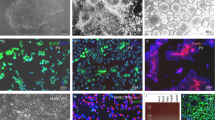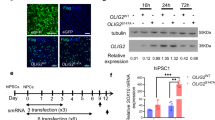Abstract
Neural progenitor cells are potential vehicles for delivery of therapeutic agents into the brain. Differentiation-dependent promoters may be useful to target the therapeutic transgene expression to specific neural cell types. Here we explored the potential of vectors based on the foamy virus (FV) for genetic engineering of neural progenitor cells. We demonstrate that FV vectors can mediate stable long-term constitutive expression of the enhanced green fluorescent protein (EGFP) in neural progenitor cells. For differentiation-dependent gene expression, we constructed a FV vector with an internal expression cassette containing the human 2.2 kb promoter (Gfa2) of the astrocyte-specific glial fibrillary acidic protein (GFAP) and sequences encoding EGFP. We show FV-vector-mediated delivery of the Gfa2-egfp transgene into the human neural stem cell line HNSC.100 and differentiation-dependent expression in stably transduced cell populations. Differentiation of the FV-transduced HNSC.100 cells to astrocytes upregulated expression of both the Gfa2-egfp transgene and the native gfap gene, confirming differentiation-dependent activation of the transduced Gfa2 promoter. These results demonstrate that differentiation-dependent gene expression can be achieved by FV-vector-mediated gene transfer to neural progenitor cells. Our findings support the use of FV vectors for the genetic engineering of neural progenitor cells for therapeutic and research applications.
This is a preview of subscription content, access via your institution
Access options
Subscribe to this journal
Receive 12 print issues and online access
$259.00 per year
only $21.58 per issue
Buy this article
- Purchase on Springer Link
- Instant access to full article PDF
Prices may be subject to local taxes which are calculated during checkout






Similar content being viewed by others
References
Muller FJ, Snyder EY, Loring JF . Gene therapy: can neural stem cells deliver? Nat Rev Neurosci 2006; 7: 75–84.
Goldman S . Stem and progenitor cell-based therapy of the human central nervous system. Nat Biotechnol 2005; 23: 862–871.
Aguzzi A, Bothe K, Wagner EF, Rethwilm A, Horak I . Human foamy virus: an underestimated neuropathogen? Brain Pathol 1992; 2: 61–69.
Rethwilm A . The replication strategy of foamy viruses. Curr Top Microbiol Immunol 2003; 277: 1–26.
Rethwilm A . Foamy virus vectors: an awaited alternative to gammaretro- and lentiviral vectors. Curr Gene Ther 2007; 7: 261–271.
Linial M . Why aren’t foamy viruses pathogenic? Trends Microbiol 2000; 8: 284–289.
Linial ML . Foamy viruses are unconventional retroviruses. J Virol 1999; 73: 1747–1755.
Delelis O, Lehmann-Che J, Saib A . Foamy viruses—a world apart. Curr Opin Microbiol 2004; 7: 400–406.
Hill CL, Bieniasz PD, McClure MO . Properties of human foamy virus relevant to its development as a vector for gene therapy. J Gen Virol 1999; 80 ( Part 8): 2003–2009.
Mergia A, Heinkelein M . Foamy virus vectors. Curr Top Microbiol Immunol 2003; 277: 131–159.
Lindemann D, Goepfert PA . The foamy virus envelope glycoproteins. Curr Top Microbiol Immunol 2003; 277: 111–129.
Nowrouzi A, Dittrich M, Klanke C, Heinkelein M, Rammling M, Dandekar T et al. Genome-wide mapping of foamy virus vector integrations into a human cell line. J Gen Virol 2006; 87: 1339–1347.
Trobridge GD, Miller DG, Jacobs MA, Allen JM, Kiem HP, Kaul R et al. Foamy virus vector integration sites in normal human cells. Proc Natl Acad Sci USA 2006; 103: 1498–1503.
Bauer Jr TR, Allen JM, Hai M, Tuschong LM, Khan IF, Olson EM et al. Successful treatment of canine leukocyte adhesion deficiency by foamy virus vectors. Nat Med 2008; 14: 93–97.
Liu W, Liu Z, Cao X, Cao Z, Xue L, Zhu F et al. Recombinant human foamy virus, a novel vector for neurological disorders gene therapy, drives production of GAD in cultured astrocytes. Mol Ther 2007; 15: 1834–1841.
Liu W, He X, Cao Z, Sheng J, Liu H, Li Z et al. Efficient therapeutic gene expression in cultured rat hippocampal neurons mediated by human foamy virus vectors: a potential for the treatment of neurological diseases. Intervirology 2005; 48: 329–335.
Bignami A, Dahl D . Astrocyte-specific protein and radial glia in the cerebral cortex of newborn rat. Nature 1974; 252: 55–56.
Rieske P, Azizi SA, Augelli B, Gaughan J, Krynska B . A population of human brain parenchymal cells express markers of glial, neuronal and early neural cells and differentiate into cells of neuronal and glial lineages. Eur J Neurosci 2007; 25: 31–37.
Pekny M, Pekna M . Astrocyte intermediate filaments in CNS pathologies and regeneration. J Pathol 2004; 204: 428–437.
Besnard F, Brenner M, Nakatani Y, Chao R, Purohit HJ, Freese E . Multiple interacting sites regulate astrocyte-specific transcription of the human gene for glial fibrillary acidic protein. J Biol Chem 1991; 266: 18877–18883.
Segovia J, Vergara P, Brenner M . Differentiation-dependent expression of transgenes in engineered astrocyte cell lines. Neurosci Lett 1998; 242: 172–176.
Jakobsson J, Rosenqvist N, Marild K, D VA, Lundberg C . Evidence for disease-regulated transgene expression in the brain with use of lentiviral vectors. J Neurosci Res 2006; 84: 58–67.
Lee Y, Messing A, Su M, Brenner M . GFAP promoter elements required for region-specific and astrocyte-specific expression. Glia 2008; 56: 481–493.
Villa A, Snyder EY, Vescovi A, Martinez-Serrano A . Establishment and properties of a growth factor-dependent, perpetual neural stem cell line from the human CNS. Exp Neurol 2000; 161: 67–84.
Rothenaigner I, Kramer S, Ziegler M, Wolff H, Kleinschmidt A, Brack-Werner R . Long-term HIV-1 infection of neural progenitor populations. AIDS 2007; 21: 2271–2281.
Badaut J, Lasbennes F, Magistretti PJ, Regli L . Aquaporins in brain: distribution, physiology, and pathophysiology. J Cereb Blood Flow Metab 2002; 22: 367–378.
Yoneda K, Yamamoto N, Asai K, Sobue K, Fujita Y, Fujita M et al. Regulation of aquaporin-4 expression in astrocytes. Brain Res Mol Brain Res 2001; 89: 94–102.
Heinkelein M, Dressler M, Jarmy G, Rammling M, Imrich H, Thurow J et al. Improved primate foamy virus vectors and packaging constructs. J Virol 2002; 76: 3774–3783.
Snyder EY, Deitcher DL, Walsh C, Arnold-Aldea S, Hartwieg EA, Cepko CL . Multipotent neural cell lines can engraft and participate in development of mouse cerebellum. Cell 1992; 68: 33–51.
Vroemen M, Weidner N, Blesch A . Loss of gene expression in lentivirus- and retrovirus-transduced neural progenitor cells is correlated to migration and differentiation in the adult spinal cord. Exp Neurol 2005; 195: 127–139.
Livak KJ, Schmittgen TD . Analysis of relative gene expression data using real-time quantitative PCR and the 2(-Delta Delta C(T)) method. Methods 2001; 25: 402–408.
Hioki H, Kameda H, Nakamura H, Okunomiya T, Ohira K, Nakamura K et al. Efficient gene transduction of neurons by lentivirus with enhanced neuron-specific promoters. Gene Therapy 2007; 14: 872–882.
Hisahara S, Araki T, Sugiyama F, Yagami K, Suzuki M, Abe K et al. Targeted expression of baculovirus p35 caspase inhibitor in oligodendrocytes protects mice against autoimmune-mediated demyelination. EMBO J 2000; 19: 341–348.
Aboody KS, Bush RA, Garcia E, Metz MZ, Najbauer J, Justus KA et al. Development of a tumor-selective approach to treat metastatic cancer. PLoS ONE 2006; 1: e23.
Dickson PV, Hamner JB, Burger RA, Garcia E, Ouma AA, Kim SU et al. Intravascular administration of tumor tropic neural progenitor cells permits targeted delivery of interferon-beta and restricts tumor growth in a murine model of disseminated neuroblastoma. J Pediatr Surg 2007; 42: 48–53.
Kim SK, Cargioli TG, Machluf M, Yang W, Sun Y, Al-Hashem R et al. PEX-producing human neural stem cells inhibit tumor growth in a mouse glioma model. Clin Cancer Res 2005; 11: 5965–5970.
Kim SK, Kim SU, Park IH, Bang JH, Aboody KS, Wang KC et al. Human neural stem cells target experimental intracranial medulloblastoma and deliver a therapeutic gene leading to tumor regression. Clin Cancer Res 2006; 12: 5550–5556.
Lee HJ, Kim KS, Kim EJ, Choi HB, Lee KH, Park IH et al. Brain transplantation of immortalized human neural stem cells promotes functional recovery in mouse intracerebral hemorrhage stroke model. Stem Cells 2007; 25: 1204–1212.
Chu K, Kim M, Jeong SW, Kim SU, Yoon BW . Human neural stem cells can migrate, differentiate, and integrate after intravenous transplantation in adult rats with transient forebrain ischemia. Neurosci Lett 2003; 343: 129–133.
Chu K, Kim M, Park KI, Jeong SW, Park HK, Jung KH et al. Human neural stem cells improve sensorimotor deficits in the adult rat brain with experimental focal ischemia. Brain Res 2004; 1016: 145–153.
Jeong SW, Chu K, Jung KH, Kim SU, Kim M, Roh JK . Human neural stem cell transplantation promotes functional recovery in rats with experimental intracerebral hemorrhage. Stroke 2003; 34: 2258–2263.
Jakobsson J, Lundberg C . Lentiviral vectors for use in the central nervous system. Mol Ther 2006; 13: 484–493.
Capowski EE, Schneider BL, Ebert AD, Seehus CR, Szulc J, Zufferey R et al. Lentiviral vector-mediated genetic modification of human neural progenitor cells for ex vivo gene therapy. J Neurosci Methods 2007; 163: 338–349.
Rubio FJ, Bueno C, Villa A, Navarro B, Martinez-Serrano A . Genetically perpetuated human neural stem cells engraft and differentiate into the adult mammalian brain. Mol Cell Neurosci 2000; 16: 1–13.
Kim SU . Genetically engineered human neural stem cells for brain repair in neurological diseases. Brain Dev 2007; 29: 193–201.
Imitola J, Raddassi K, Park KI, Mueller FJ, Nieto M, Teng YD et al. Directed migration of neural stem cells to sites of CNS injury by the stromal cell-derived factor 1alpha/CXC chemokine receptor 4 pathway. Proc Natl Acad Sci USA 2004; 101: 18117–18122.
Xu Q, Wang S, Jiang X, Zhao Y, Gao M, Zhang Y et al. Hypoxia-induced astrocytes promote the migration of neural progenitor cells via vascular endothelial factor, stem cell factor, stromal-derived factor-1alpha and monocyte chemoattractant protein-1 upregulation in vitro. Clin Exp Pharmacol Physiol 2007; 34: 624–631.
Faijerson J, Tinsley RB, Aprico K, Thorsell A, Nodin C, Nilsson M et al. Reactive astrogliosis induces astrocytic differentiation of adult neural stem/progenitor cells in vitro. J Neurosci Res 2006; 84: 1415–1424.
Brenner M . Structure and transcriptional regulation of the GFAP gene. Brain Pathol 1994; 4: 245–257.
Heinkelein M, Schmidt M, Fischer N, Moebes A, Lindemann D, Enssle J et al. Characterization of a cis-acting sequence in the Pol region required to transfer human foamy virus vectors. J Virol 1998; 72: 6307–6314.
Heinkelein M, Thurow J, Dressler M, Imrich H, Neumann-Haefelin D, McClure MO et al. Complex effects of deletions in the 5′ untranslated region of primate foamy virus on viral gene expression and RNA packaging. J Virol 2000; 74: 3141–3148.
Radonic A, Thulke S, Mackay IM, Landt O, Siegert W, Nitsche A . Guideline to reference gene selection for quantitative real-time PCR. Biochem Biophys Res Commun 2004; 313: 856–862.
Acknowledgements
We thank Elisabeth Kremmer (Munich) and Katrin Peters (Würzburg) for reagents and advice and Kamyar Hadian for critical reading of the paper. This study was supported by the German Research Council (DFG), Priority Program (SPP) 1230 and by the Research Program ‘Infection and Immunity’ of the Helmholtz Association.
Author information
Authors and Affiliations
Corresponding author
Rights and permissions
About this article
Cite this article
Rothenaigner, I., Kramer, S., Meggendorfer, M. et al. Transduction of human neural progenitor cells with foamy virus vectors for differentiation-dependent gene expression. Gene Ther 16, 349–358 (2009). https://doi.org/10.1038/gt.2008.173
Received:
Revised:
Accepted:
Published:
Issue Date:
DOI: https://doi.org/10.1038/gt.2008.173
Keywords
This article is cited by
-
Advances in Foamy Virus Vector Technology and Disease Correction Could Speed the Path to Clinical Application
Molecular Therapy (2012)
-
Progress and prospects: Foamy virus vectors enter a new age
Gene Therapy (2010)



